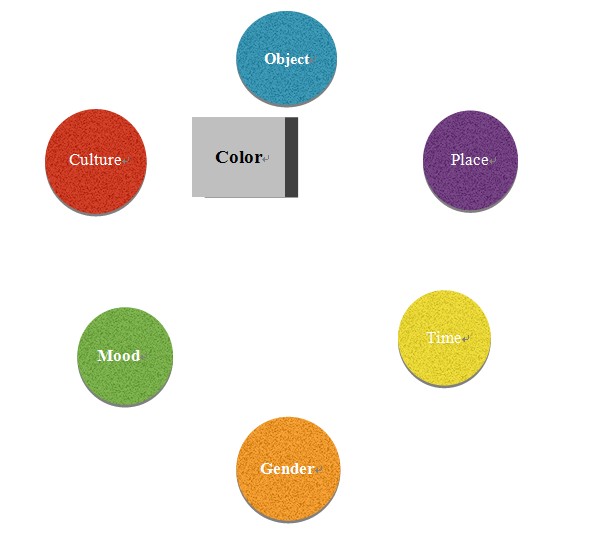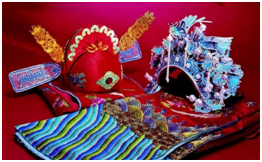来源:环球教育
小编:环球教育 179雅思口语考试中,关于颜色的问题当然不止“ What color do you like?” 这么简单。想要对颜色问题应对自如,关键要学会如何将颜色和其他话题联系起来,以下这幅图展示的就是颜色和它的“小伙伴们”,分别为:物品、文化、情绪、性别、时间、地点,它们通常会与颜色出现在同一个问题中。接下来环球教育名师给大家逐一分析一下颜色和它们每一个之间的关系。

Object |
1. 颜色与物品
代表问题:Is color an important factor that you will consider when you choose things?
你会用什么颜色的物品通常取决于你喜欢什么颜色,但在挑选不同物品时,你对颜色的选择会发生变化。举个最简单的例子,许多人喜欢穿红色的衣服但不见得会穿红色的鞋子。照这个思路,你可以说:When I choose things, the colors I’d pick vary from things to things. For example, I like wearing clothes with vibrant colors (鲜艳的色彩) like red and orange, but I prefer dark colors for shoes because shoes get dirty easily and the dirt will look obvious if the color is light. 另外,就算同样是衣服,你夏装和冬装的色彩还可能截然不同呢。所以你还可以说:The colors I choose for clothes in different seasons are not the same. Most of my summer dresses have catchy colors (抢眼的颜色), but my coats for winter are mostly with dull colors (暗淡的颜色) like grey and black.
在考试中,除了衣服外,会与颜色结合在一起的物品还包括汽车和墙纸,参考问题为:Do you think the color of cars is important? What color do you want for your wallpaper?
2. 颜色与文化
代表问题:What colors are popular / not popular in your country?
谈到颜色和文化,不同文化中每种颜色的含义是不一样的。就中国文化而言,比较有代表性的几种颜色为:红色(象征吉祥joy、幸福happiness、繁荣prosperity)、黄色(象征财富wealth、高贵high class、皇室royal family)、白色(象征死亡death、葬礼funeral)。回答什么颜色受欢迎或不受欢迎的问题,还可以结合庆祝活动(celebration)与仪式(ceremony)。例如:Red is a color beloved by the Chinese because it symbolizes (象征) joy, happiness and prosperity. In China, red is a dominant color (占主导地位的颜色) for almost all the celebrations, such as weddings, birthdays, and the Spring Festival. White seems like an unpopular color because it means death on funerals in China. When Chinese people attend a funeral, they’re usually dressed in white and take white chrysanthemums (菊花) to the cemetery (墓地).
另外,下面再给大家补充一些西方文化中不同颜色的含义:
Color | Meaning |
| warmth, love |
| cheerfulness, enthusiasm |
| comfort, happiness |
| nature, calm |
| peace, loyalty |
| luxury, magic |
| serious, uninteresting |
| relaxing, confident |
| power, night |
| cleanliness, purity |
3. 颜色与情绪
代表问题:How do colors affect people’s mood?
颜色对情绪的影响,讲专业些就是颜色的心理意义(psychological meaning / value),讲通俗些就是一些颜色能使人开心,一些使人平静,一些甚至使人愤怒或悲伤。在大多数人看来,颜色和情绪之间的关系应该是这样的:

再说一个生活中常见的情况,房间墙面颜色会给人以不同的感觉,所以装修的时候会考虑到这一点而选择合适的颜色来粉刷墙壁。这该如何表达呢?你可以说“decorate the room with colors in the right tone for the mood I want to have” 或者“find the paint color that matches the mood I want”。然后接着具体说如何选颜色,例如:Orange makes me full of energy so I’d love to paint the living room this color. For the bedroom, I think light blue would be a good choice because it feels relaxing and serene.
4. 颜色与性别
代表问题:What are the differences between men and women when they look at the same color?
女性一般喜欢比较柔和的颜色(soft color),而且许多女生都是粉色控(pink mania),相比之下,男生挑选东西总是黑灰色系(neutral color)。
针对同一个颜色,男女看法也可能大相径庭。比方说粉色:Most women have had a dream of being a princess since they were little, so they just can’t say no to pink which is a lovely color in their eyes. But many men can’t stand this color and it’s no way for them to own something in pink. 再比方说白色:Women tend to see white as holy and pure because white is the color of bride’s wedding dress. For men, white may not have any special meaning but just a common color of their shirts and sneakers.

5. 颜色与时间
代表问题:Are there any changes in the use of colors in the past and in the present?
关于颜色在不同时期的不同使用,在这里给大家几个例子作为参考。古代中国只有皇帝才可以穿黄色的衣服,只有宫殿的墙壁才能刷成红色,结婚新郎新娘的礼服一定是红色,如今关于这些颜色的规定和禁忌早已不复存在或没那么严格了。
e.g. In ancient China, there used to be strict rules for the use of certain colors. For example, yellow was the color used on imperial robes (龙袍), so no one else than the emperor could wear yellow. And only the walls of the imperial palace (皇宫) could be painted red. When a couple got married, red was the color of their wedding gown, no exception (无一例外). Nowadays, such rules no longer exist. Anyone can wear yellow, many houses have red walls, and young people who are keen on western culture prefer to wear white wedding dress on their wedding day.

![L1YORJ50QYFE3]72JV_0U$A.png](http://file1.gedu.org/c7ad93a5-c6fe-43e3-aad7-5286007187bc/2015/0818/31e6a179-375d-429a-87d6-eb18b7a66afe.png)
6. 颜色与地点
代表问题:Describe a place you went to which is full of colors
“多彩之地”是今年1月换题期出现在Part 2的一个新题。以下给大家一些地点作为参考:
• 拥有自然风光的景点(scenic spot / tourist attraction with natural beauty)
• 花园(garden)/ 花展(flower exhibition)/ 花店 the florist’s
• 游乐园(amusement park)
• 动漫展(cartoon exhibition)
• 糖果店(candy store)
• 书店(book store)
• 画廊(gallery)
